Do you know what Github, Dribbble, and Shopify have in common? Being monsters in their niches now, all of them used great opportunities of Ruby on Rails for kick-starting.
Why do so many startups and solid companies choose and continue using RoR as their technology platform? The most important thing for a web product startup is a stable, fast, and secure solution. And Ruby on Rails is reliable and at the same time cost-effective framework, which will ensure a fresh start.
In this article, we’ll try to clear out why startups use Ruby on Rails, and what benefits RoR can bring to your product.
1. A startup-intended framework
Ruby on Rails was developed by David Heinemeier Hansson in 2003 when he was working on Basecamp - the first-ever Ruby on Rails application. Later David released RoR as open-source, and the framework now serves as an excellent tool for startups management.
For over a decade, Ruby on Rails has established its active position, having proved to be a mature technology solution for businesses.
How popular is Ruby on Rails framework at the moment? Currently, according to BuiltWith, there are 1,508,526 websites in the world, which use Ruby on Rails.
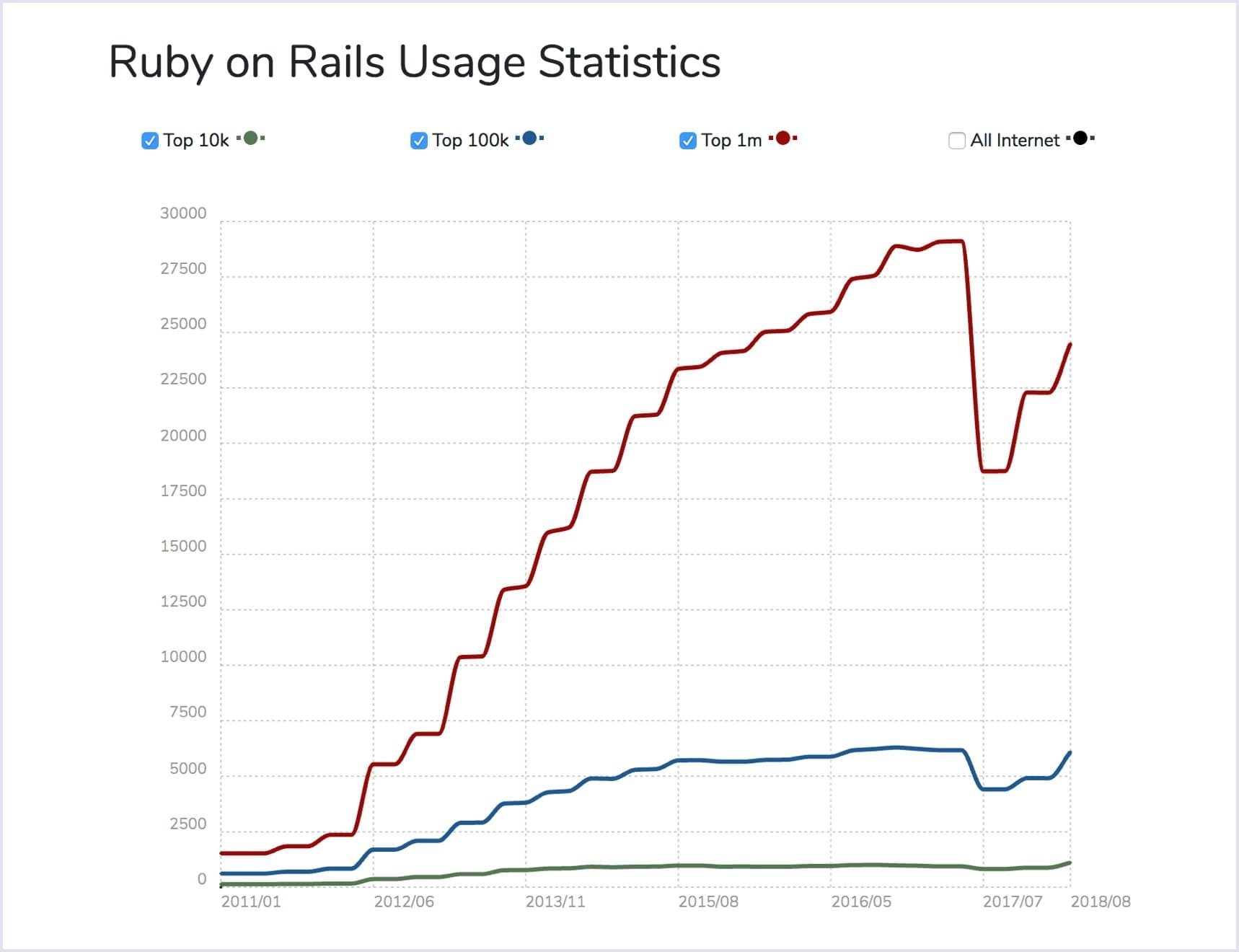
(Data is valid for August 2018)
Source: BuiltWith
The global trend of using Ruby on Rails framework is growing.
What makes it suitable to launch your ideas? Let’s figure this out.
2. Time- and cost-efficient
Ruby on Rails helps you quickly build the MVP to enter the market
One of the best ways to offer the basic version of your future solution to investors or consumers is building a Minimum Viable Product (MVP).
Building an MVP on Ruby on Rails is very popular with numerous startuppers around the world. Why is it so? Rails framework has a lot of features that allow rapid prototyping. Along with the ready-made modules, they make Rails a very flexible framework. This characteristic allows to build the future product with several major features and roll it out on the market within a few days.
See also: How to Create a Minimum Viable Product (MVP)?
For example, when Airbnb came up with the idea to create their service, they had almost no resources. They created an MVP as the plainest website ever with a few photos. The decision appeared to be life-changing.
Here’s a screenshot of one of the first versions of airbnb.com. Looks very different from the current website, right?
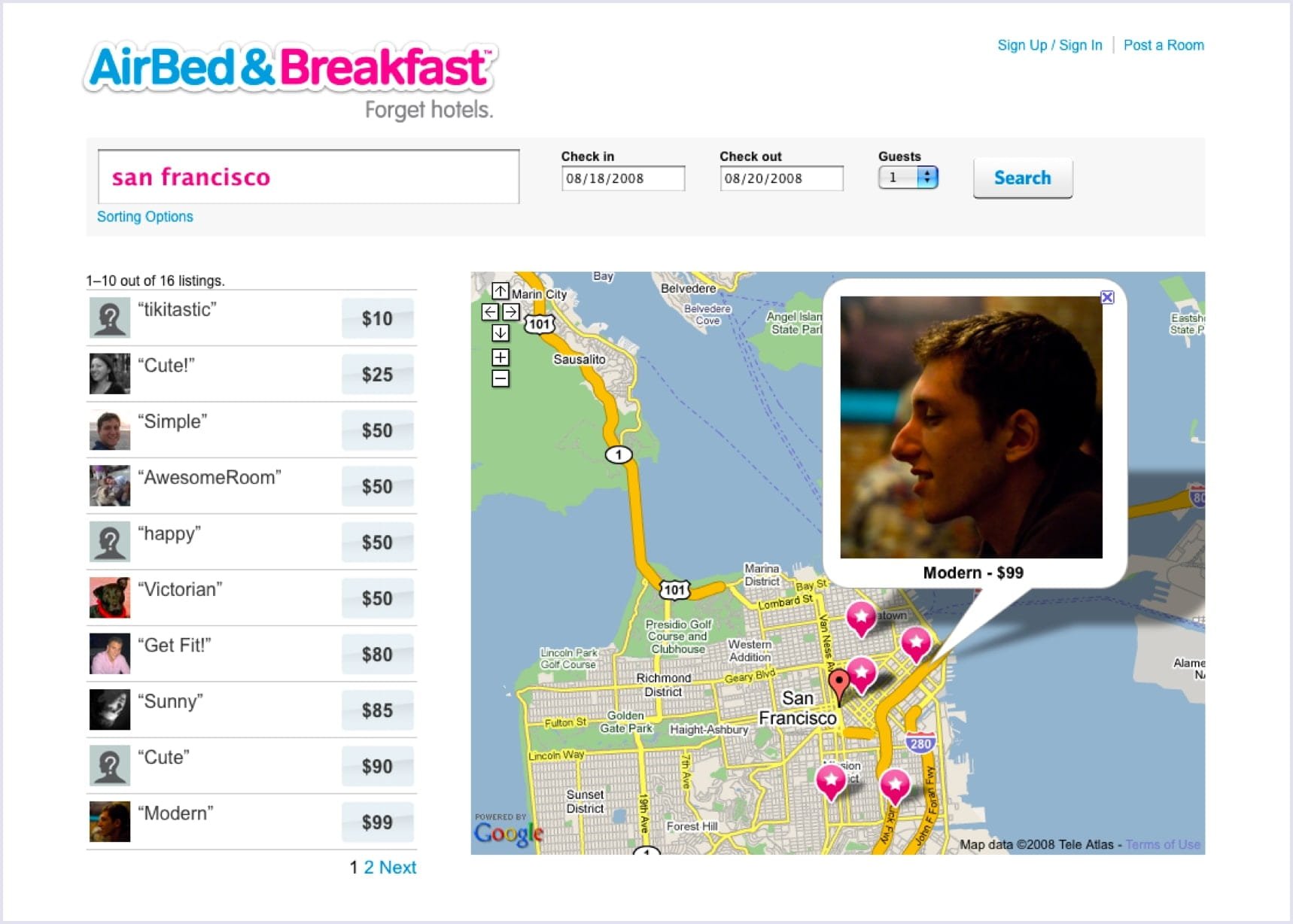
Source: TechCrunch.com
What accelerates development in Ruby on Rails so much?
Rails itself
Rails framework is a set of gems with everything necessary for quickly developing a website of any complexity.
The architecture allows modeling the concept along the line. In a nutshell, Rails is like a Lego. Programmers integrate blocks of solutions that have already been tackled. With RoR, the right compiling is a time-saving process.
Model-View-Controller
This architectural pattern is like an organizer. It separates the code functionality into layers. When following the MVC principle, developers focus on tasks which genuinely matter without distracting on messy details or the code structure.
Convention over configuration
The strategy dramatically simplifies the process of development. If following Rails built-in sets of rules, developers reduce the number of decisions to be taken. It keeps the code flexible and straightforward.
Sam Ruby is one of the authors of “Agile Web Development With Rails” and a member of Apache Software Foundation board of directors. As a great contributor to open-source software, here’s what he thinks about RoR:
What sets this framework apart from all of the others is the preference for convention over configuration, making applications easier to develop and understand.
Gems
Gems are free open-source libraries which number over 147 199 at the moment.
The gems significantly accelerate the app development, because programmers don’t need to ‘reinvent the wheel’ over and over again. Many functions are already written, and many issues are already solved and are freely available to download.
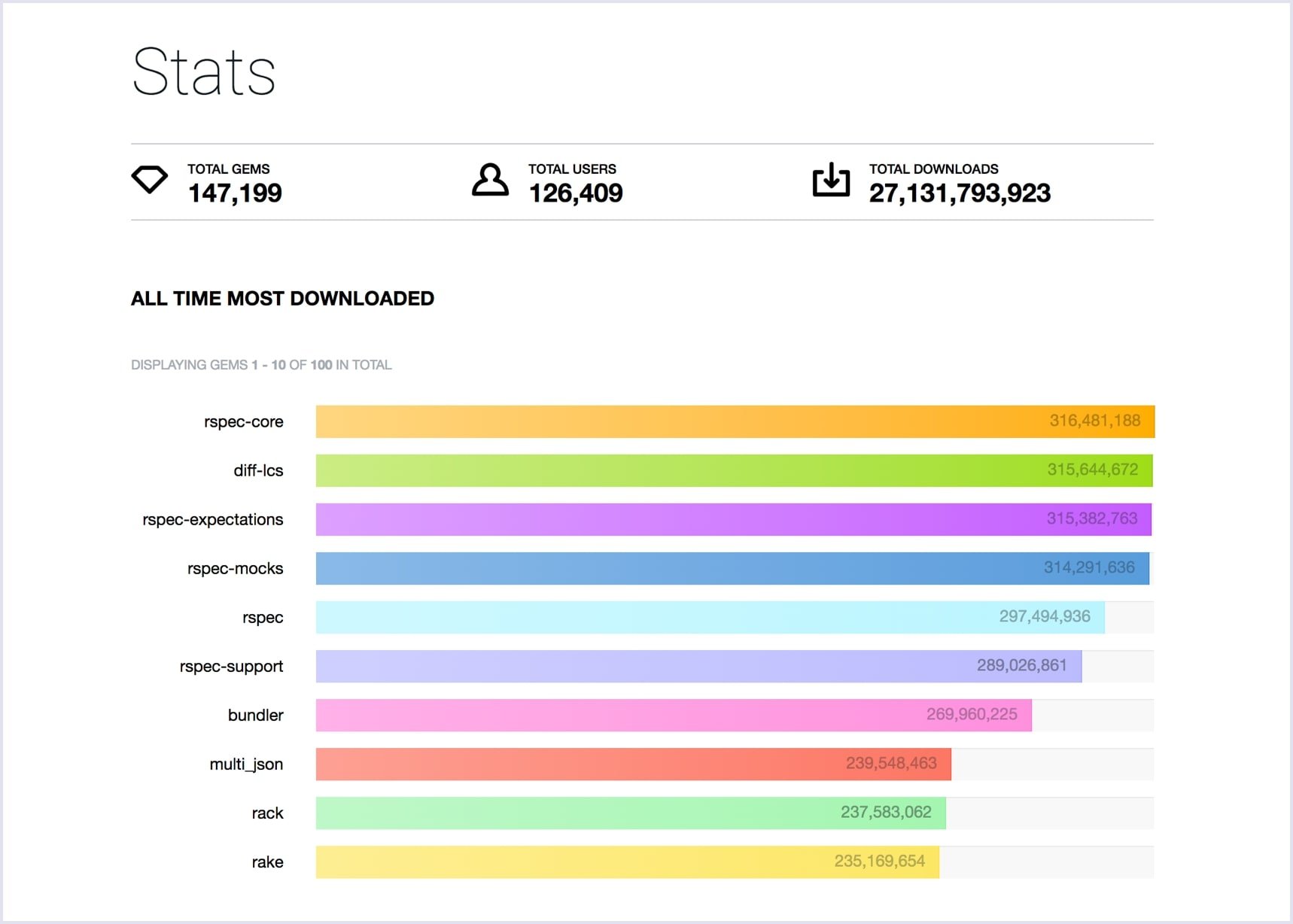
Source: rubygems.org
As you can see, there is a considerable number of Ruby Gems, but the number is not the most important thing. The most important is that they allow to quickly implement your project features, by putting together the functionality pieces available out of the box.

Of course, all this means less time required for any project development and launch.
All these options impress both developers and business people. Tim O’Reilly, Founder of O’Reilly Media, says:
Ruby on Rails is a breakthrough in lowering the barriers of entry to programming. Powerful web applications that formerly might have taken weeks or months to develop can be produced in a matter of days.
And we definitely agree with him.
No matter what their budget is, startups are looking for the options to develop their initial products for a reasonable cost. Rails allows generating a robust and high-quality web application within an affordable budget. This is possible due to ready open-source solutions written before.
Fewer development hours = smaller costs of creating your web solution.
3. Ensures a high-quality product
Any web solution must be solid.
Programming in Rails goes hand in hand with the two following methods which ensure the reliability of the solution:
Test Driven Development (or just TDD) approach involves development through testing. It includes tools allowing to carry out fully automated, integrated and functional testing.
Behaviour Driven Development (or BDD) evolved from TDD, and together they guarantee a high-quality web solution. While TDD helps test the technical aspect of the product functionality, BDD checks whether a business task is fulfilled correctly.
Though these two methodologies were not initially invented by Rails evangelists, together they make a strong alliance for a project’s reliability and are recommended to use in project development by the RoR community.
Why should you care? Your product’s code quality has a direct impact on the strength of your startup as a whole.
You can be sure that choosing Ruby on Rails for creating your product, you will get a high-quality solution for a reasonable cost.
4. Ruby on Rails is scalable
As it happens with startups, your project may change and grow. Over time, it will scale, and this might affect the app’s or website’s ability to maintain high traffic.
With this in view, your application must be ready to manage increased loads and process growing requests per second. At the end of the day, your primary goal is engaging more and more consumers across the web. So why not prepare for that?
Sometimes growth might be a problem with any other framework, but not with RoR.
Speaking of scalability, let’s look at Shopify, which processes about 4 mln requests per second, Github with over 28 million users and 57 million repositories, and Airbnb, hosting over 5 mln listings in more than 190 countries. All of them use RoR.
Resistance to high loads is the significant achievement of Rails. At the same time, it’s not only about the framework itself. Scalability also depends on your servers capacity, deployment strategy, database architecture and the system as a whole. The Rails framework allows building solutions resistant to high loads and is perfect for deploying and working in servers clusters and cloud development services.
We would love to provide you with a high-quality solution!
5. Rails is secure and reliable
When just beginning a business, startuppers think of security least. This is totally understood: you need the product created fast to enter the market quickly.
However, protection of your web solution shouldn’t be neglected. The more secure it is, the smaller is the risk of being attacked, or hacked, or discovering vulnerabilities. The main point: safety directly impacts long-term business sustainability.
So, sooner or later, you will consider your product security. But if you decide to switch to a more secure framework, this will take some time and effort. Of course, the best option would be starting with a persistent solution which would stay safe and sound day and night.
With Ruby on Rails, you don’t need to spend time on extra features to make your solution resistant to vulnerabilities.
This is provided by the built-in system of protection against threats and attacks which might be the following:
Cross-site Scripting (XSS)
Insecure Direct Object Reference or Forceful Browsing
CSRF (Cross Site Request Forgery)
The Rails framework is secure out of the box, so you don’t need to worry about this aspect at any stage of your business.
6. Easy to support with strong ecosystem
Rails was created in 2004, and it’s a mature framework with mass support, a lot of resources and an active community.
According to Github statistics for 2017, Ruby was in Top-5 by the number of pull requests.
The framework is developing, and regularly provides new notable options for programmers. The recently released Rails 5.2.1, has many improvements, such as new Active Storage framework or enhanced level of file encryption.
Though Rails 6 is only expected at the beginning of 2019, forecasts for this release are promising. One of the most significant technical innovations is Action Text framework which will simplify working with rich text content. Along with that, the Rails community promises to roll out other major framework improvements.
Remember the Gems that we mentioned previously? The community regularly updates them.
Speaking of numbers, new versions of 55 Gems were released only on 10 October 2018, the day when this article was created. Here are a couple of examples:
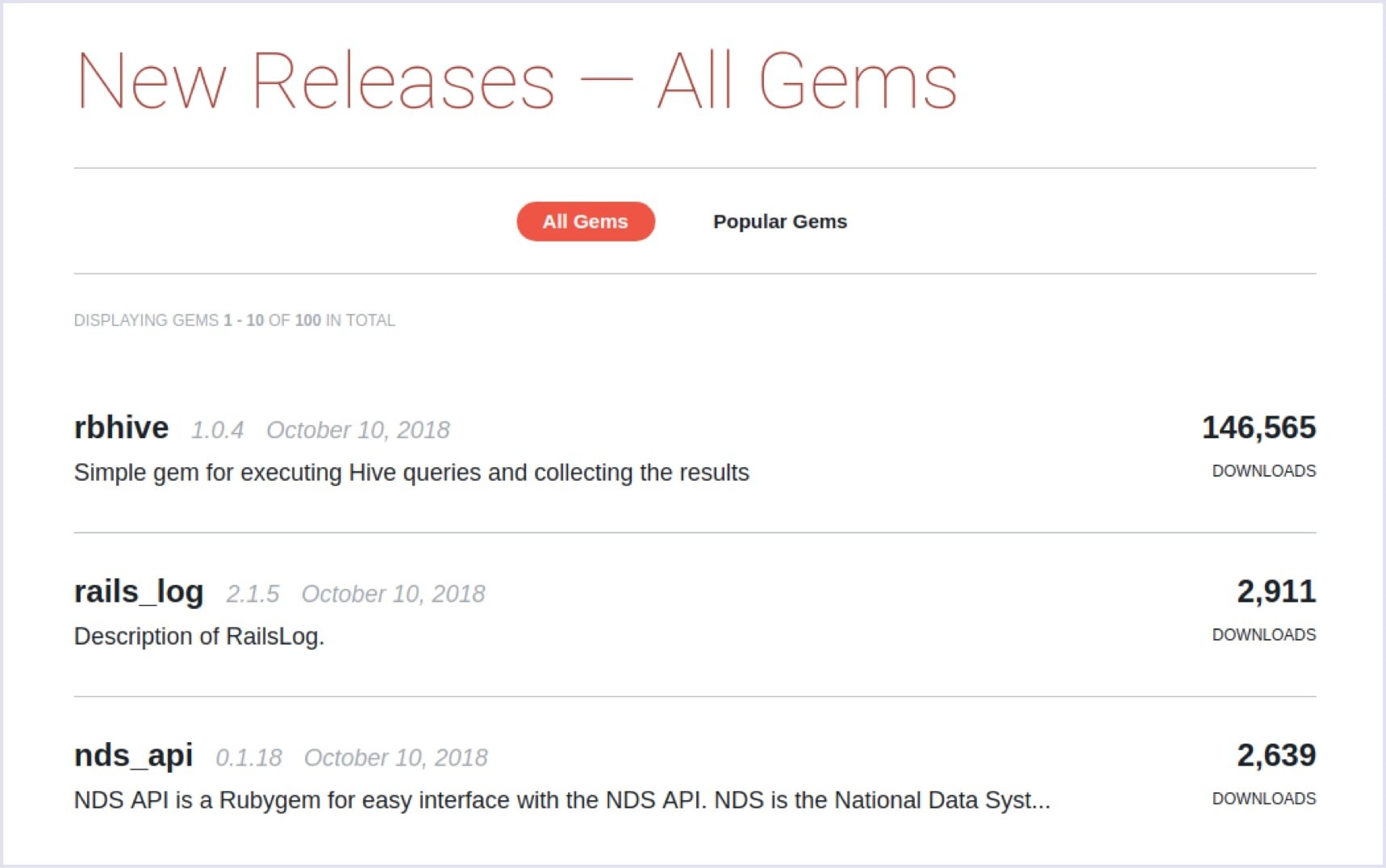
Source: rubygems.org
At the same time, gems are not the only the only community’s contribution. Detailed and clear documentation is another valuable input of many RoR-enthusiasts. Besides, they create numerous tech guides and lessons.
In addition, the Rails community is always ready to assist with solving problems. If there are some issues on the project, RoR developers won’t stick around helpless, and the answer will be found in a few minutes. All they have to do is just ask for advice at Github or StackOverflow. Luckily, these platforms host enough skilled programmers and contain rich repository.
7. Provides access to a high-quality talent pool
Having qualified experts on the project is vital for success. The more skilled programmers are, the more carefully considered, scalable and faster your product will be.
RoR developers are well-trained coders because Ruby is not that easy to learn. People who code in Ruby, usually have already mastered other programming languages, in most cases - more than one.
In Ruby, the experience in programming goes along with motivation and dedication to work. Ruby developers are often in love with the language and the Rails framework and are passionate about what they do.
Ruby on Rails has a very developed community, which often hosts different conferences and smaller events, where programmers can share their knowledge and gain something new.
Basically, when hiring RoR-developers for your startup, you get 4-in-1: dedication to coding, motivation to work, high skills in programming, and great experience in what they do.
Successful startups using Ruby on Rails
A large number of famous startups used and still are using advantageous solutions of Ruby on Rails.
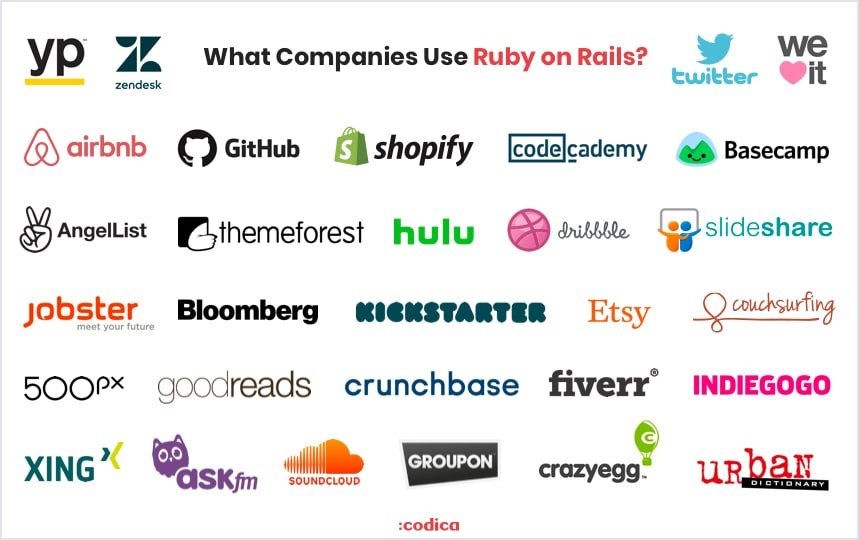
Let’s take a closer look at some of the most successful, brightest and high-profile ones.
Airbnb
Airbnb is probably one of the most known giants in the rental industry. The startup was launched in 2007 by 2 roommates, Brian Chesky and Joe Gebbia. In the beginning, they built a plain website with 3 photos uploaded, bought a few air mattresses, and had their first booking. They had a long way to go.
For today, Airbnb has over 3000 employees, includes more than 5 mln listing all over the world, operates almost in 200 countries. For ten years, more than 400 mln guests experienced Airbnb. Each night over 2 mln people stay at Airbnb. And the company is still scaling.
Related reading: How to build a website like Airbnb
Github
Github is a web-based version control platform. This hosting service was launched in 2008 by Chris Wanstrath, PJ Hyett, Tom Preston-Werner and Scott Chacon. For building the solution, they used Ruby on Rails, and the framework was never changed.
For now, Github has about 800 employees, hosts about 30 mln registered users globally, and includes more than 57 mln repositories. In June 2018 Microsoft announced on acquiring Github for $7,5 bln with the deal close at the end of the year.
Shopify
Shopify is an e-commerce platform for online stores and retail point-of-sale systems. It was established in 2004 by Tobias Lütke, Daniel Weinand, and Scott Lake. The original online store was named Snowdevil. One of the co-founders, Tobias Lütke, was a computer developer, and he used Ruby on Rails to build the solution. Development and launching took them 2 months.
Shopify product as we know it now started off in 2006. At the moment, the platform is used by over 600, 000 merchants. It serves globally with 3000 employees aboard. As for 2017, Shopify’s total gross merchandise volume exceeded $55 bln, with over $590 mln revenue for that year.

Source: twitter.com
To conclude
Our experience shows that Ruby on Rails is a great solution for startups. We love this framework, even though use others as well. If you are an aspiring startupper, we are ready to boost your project, using all the mentioned features we enjoy about Ruby on Rails.
We are proud to say that our custom software development company has helped many startups create their MVP with RoR, which helped them get further funding and develop their products to new levels.
Want to know more? Check our case study on a vehicle marketplace - a startup which raised $1 mln of investment, and has now turned into a multi-website platform.
Interested in developing your own web product? Let’s get in touch and see how we can help bring your ideas to life!
